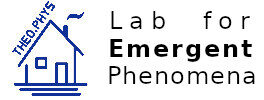PhD thesis – René Wittmann
René Wittmann
Density Functional Theory for Liquid Crystals — Refining Fundamental Measure Theory for anisotropic bodies [PDF]
finished 2015-07
supervised by Matthieu Marechal, Klaus Mecke
Liquid Crystals exhibit various degrees of positional and orientational order and thus constitute a state of matter intermediate between an unordered liquid and a perfectly ordered crystal. In order to get deeper insights into colloidal and molecular many-particle systems, a comprehensive theory from first principles is essential.
Fundamental Measure Theory (FMT) constitutes an elegant geometrical framework within classical density functional theory. It accurately describes inhomogeneous systems of hard spherical particles in equilibrium, which are a common model for simple colloids. A similar approach for anisotropic shapes is more involved, as the pair interaction potential additionally depends on the orientations of both particles in a non-trivial way. Moreover, it is found in this work that some variants of the hard-sphere functional are not appropriate for extremely anisotropic shapes.
In this thesis, I pursue two goals to improve upon current FMT functionals. Firstly, I derive Fundamental Mixed Measure Theory (FMMT), a new generalization of FMT to anisotropic bodies with arbitrary (convex) shape, which is exact in the low-density limit. Integral geometry tells us that it is not possible to factorize the Mayer function, describing the interaction between two hard bodies, into a finite number of one-body measures unless both bodies are spheres. I introduce FMMT by employing a recent theorem from integral geometry. The resulting decomposition of the Mayer function in Eq. (3.2.37) contains a novel geometrical measure depending on two bodies simultaneously. Secondly, I discuss different approximations to better describe the dense system.
To test these new versions of FMT, I reconsider some well-studied systems, mostly consisting of hard spherocylinders. In particular, I study the phase diagram including the isotropic, nematic and smectic-A phase, the isotropic–nematic interface and the Frank elastic coefficients of the nematic phase in chapter 5 and onwards.
The geometric nature of FMMT allows us to solve several problems analytically, or make at least some preliminary simplifications. I derive a general method to calculate the elastic coefficients according to Eq. (5.3.7). The resulting analytical expressions are discussed in the low-density limit, providing the required input to the closed formula for the isotropic–nematic interfacial tension from Eq. (2.2.50), found within a Landau-de Gennes theory reformulated for hard bodies. Linearizing the FMMT functional, the free energy of the form given by Eq. (4.2.73) can be discussed analytically for smectic-A phase. Restricting the orientational degrees of freedom, it is possible to describe the Liquid Crystal phases of hard spherocylinders analytically using the full FMMT functional.
To facilitate the numerical implementation of FMMT for a system with free orientations, I validate two approximations to the two-body measure in FMMT. Truncating a systematic expansion after a few terms yields accurate results for hard spherocylinders with a finite length, as long as the orientational distribution does not depend on the position, which is discussed in Sec. 7.2. According to Sec. 7.3, the rescaling of the first term of this expansion with a local function of this order parameter constitutes a simpler and more general approach. The original strategy to employ a constant correction results in a poor description of all inhomogeneous problems.
The requirement of a finite free energy per particle in a system of infinitely long rods does not allow all possible combinations of the building blocks of FMMT at finite density. In particular, the originally proposed form is excluded, which also comes into effect in its failure to predict a stable smectic-A phase. As long as no additional measures are introduced, the FMMT functional including the term in Eq. (8.2.10) is the only version which has both the correct scaling behavior and the correct dimensional crossover properties, being a necessary criterion to describe the solid state. Particularly after a convenient semi-empirical choice of the prefactor to this expression, the the description of hard spherocylinders in Sec. 8.2.3 is quantitatively accurate. None of the proposed more general approximations is found to be superior, when we also take into account the need for an efficient implementation.
As the essential result of this work, I provide a sophisticated theoretical framework to predict the physical properties of a fluid from the microscopic geometry of its particles. Such a theory allows a straightforward calculation of interfacial tensions or elastic parameters, which requires a huge effort in computer simulations. The accuracy of the refined FMMT for hard spherocylinders suggests future applications to mixtures or arbitrary external potentials. The functional can be used as a starting point to describe more realistic systems with long-range interactions. It is also possible to discover new phenomena when studying complex particle shapes.
